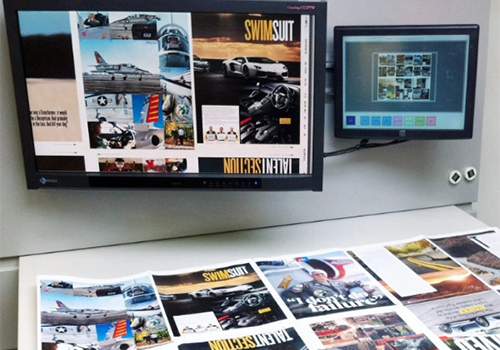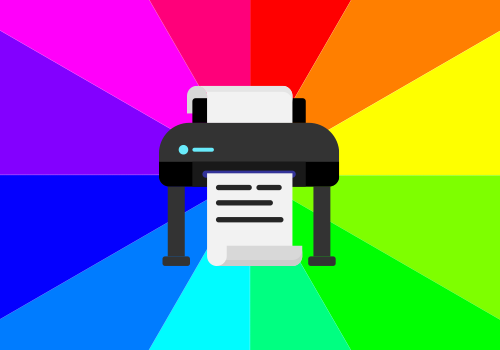The Importance of Soft Proofing with Colour-Managed RIP Software
In the competitive world of printing, achieving precise colour accuracy is of utmost importance. Whether it's for a brochure, packaging, or a billboard, maintaining faithful colour reproduction is the cornerstone of print quality. This is where the concept of soft proofing, available with Serendipity's options of Blackmagic and Megarip, or with Veripress (a dedicated soft proofing product), emerges as a game-changing innovation.
Soft proofing is a critical step in ensuring that the colours and elements of a design will appear as intended on the final printed product. This digital simulation process is that crucial stage where we verify that the colours and elements in a design will look exactly as we intend on the final printed piece.
So, what exactly is soft proofing, and why is it so significant?

Soft proofing is the digital depiction of how a print job will appear on the selected output device, be it a high-quality printer, offset press, or even a large-format display. Instead of the laborious process of producing physical hard proofs (which can be time-consuming and costly), soft proofing enables us to employ specialised software to replicate the appearance of the final piece directly on our computer screens.
Soft proofing is a game-changer because it stands in stark contrast to traditional hard proofing methods. With hard proofs, one physically prints a sample on the intended material. While tangible, they come with a cost, consume time, and don't always perfectly align with the final output due to variables like ink density, paper type, or the printing technology utilised.
Achieving consistent colour accuracy across different devices and substrates is a daunting task in the print industry. Without soft proofing, designers and printers would be left guessing about colour adjustments, often leading to frustrating discrepancies between the intended and actual printed results.
Colour Management in Printing
Colour management is the backbone of consistent and accurate colour reproduction in the print industry. It's a meticulous process that ensures the colours you see on your screen are faithfully reproduced on the printed page, despite the differences in the devices and materials involved.
It involves the use of colour profiles and calibration techniques to maintain colour consistency across various devices, such as monitors, printers, and presses. Colour management addresses factors like colour space, gamut, and rendering intent to achieve the best possible colour match.
A key component of colour management is the use of ICC (International Color Consortium) profiles. These profiles serve as standardised dictionaries that define how colours are translated between different devices. They ensure that a specific colour in a digital design file is accurately interpreted by the printer, regardless of the technology or substrate.
Achieving seamless colour management in the print industry is not without its challenges. Different devices have varying colour gamuts, and factors like lighting conditions, substrate properties, and environmental variables can influence colour perception. This complexity can lead to discrepancies in colour reproduction if not carefully managed.
Moreover, the print industry encompasses a wide array of materials, from glossy paper to fabric to rigid substrates, each with its unique colour characteristics. This diversity makes it even more critical to have robust colour management practices in place.
Efficient colour management is crucial not only for maintaining brand consistency but also for reducing waste, saving time, and enhancing the overall quality of printed materials. It's the linchpin that connects the design, pre-press, and production stages, ensuring that what you envision on your computer screen aligns perfectly with the final printed output.
RIP Software and Its Functionality
Raster Image Processor (RIP) software plays a pivotal role in transforming digital design files into the vibrant, tangible prints we see. The software serves as the translator between your digital design and the printing press or device. It takes the intricate details of your design file—colours, fonts, images—and converts them into a language the printer can understand. Think of it as the intermediary that ensures seamless communication between your computer and the printing hardware.
One of the primary functions of RIP software is to interpret and process colour data. It does this by translating the colours in your design file into the specific ink or toner combinations needed to reproduce those colours accurately on paper or another substrate. This process involves converting RGB (Red, Green, Blue) or CMYK (Cyan, Magenta, Yellow, Key/Black) colour values into the appropriate printing ink percentages.
Blackmagic and Megarip offer several key advantages in the print industry. Firstly, they ensure colour consistency across various print jobs, devices, and substrates. This consistency is essential for maintaining brand identity and delivering the quality clients expect.
Secondly, the software optimises colour reproduction, helping to achieve accurate and vibrant results. It can perform colour corrections, fine-tune colour profiles, and manage colour gamuts to ensure that the printed output matches the original design intent.
Lastly, the software enhances efficiency by streamlining the printing process. They can handle complex tasks like nesting multiple designs on a single sheet, managing print queues, and automating colour management tasks, saving both time and resources.
The Role of Soft Proofing in Colour Management
Soft proofing is the bridge between the digital design world and the physical print. It allows designers, printers, and clients to preview how a design will look on the chosen substrate and printing device before incurring the cost of production. This visual assessment is a cornerstone of colour management, enabling stakeholders to identify and rectify any discrepancies between the digital design and the expected printed output.
Soft proofing offers a real-time, on-screen representation of how colours, images, and layouts will appear on the printed piece. It considers various factors like colour profiles, rendering intents, and the capabilities of the output device. Designers can assess the impact of colour choices, contrast, and saturation, ensuring that the final result aligns with the creative vision.

One of the key advantages of soft proofing is the ability to make colour adjustments in the pre-press stage. Colour-managed RIP software plays a pivotal role here by providing accurate colour rendering on the screen. Designers and print professionals can fine-tune colours and ensure that the intended colour accuracy is achieved.
This proactive approach minimises the need for costly reprints and revisions after the production has started. Soft proofing empowers stakeholders to catch and address colour discrepancies early in the process, saving both time and resources.
Moreover, soft proofing encourages collaboration among design teams, clients, and printers. It allows for a shared understanding of the final product's appearance and facilitates communication regarding colour expectations.
This collaboration results in a streamlined, efficient workflow where designers and printers can confidently make colour decisions based on the soft proof, knowing that the final print will closely match their expectations. It minimises the chances of costly colour discrepancies and enhances the overall quality of the printed materials.
Challenges and Solutions
While soft proofing with colour-managed RIP software brings remarkable advantages to the print industry, it's not without its challenges. In this section, we'll explore these common hurdles and provide practical solutions and best practices for overcoming them.
- Display Calibration: The accuracy of soft proofing heavily depends on the calibration of the computer monitor used for previewing. Variations in monitor settings, ageing screens, or incorrect calibration can lead to inaccurate colour representation. Solution: Regularly calibrate monitors using hardware or software calibration tools to ensure accurate colour display.
- Viewing Conditions: The lighting conditions in which soft proofs are viewed can significantly impact colour perception. Inconsistent lighting can lead to discrepancies between what's seen on the screen and the printed result. Solution: Maintain consistent and controlled lighting conditions in your proofing environment.
- Colour Gamut Mismatch: Not all colours visible on a monitor can be reproduced accurately in print due to differences in colour gamuts between devices. Solution: Use colour-managed RIP software to accurately simulate how colours will appear on the chosen printing device and substrate, allowing you to make informed colour adjustments.
- File Format Compatibility: Some design files may not be compatible with the chosen software, leading to potential rendering issues. Solution: Ensure your design files are in compatible formats and consider converting them to formats that work seamlessly with your software.
- Colour Profiles: Mismatched or incorrectly configured colour profiles can result in colour inaccuracies during soft proofing. Solution: Use standardised ICC profiles and ensure that they are applied consistently across the entire workflow, from design to printing.
- Limited Colour Options: Some printing devices may have limitations in the range of colours they can reproduce accurately. Solution: Understand the colour capabilities of your chosen output device and make design decisions that work within those limitations.
- Cost Considerations: While soft proofing can save on production costs compared to hard proofs, it does involve investments in software, hardware, and training. Solution: Weigh the initial costs against long-term savings and improved print quality to justify the investment.

By addressing these challenges and implementing best practices, you can maximise the benefits of soft proofing with colour-managed RIP software. The combination of accurate colour representation, early error detection, and efficient collaboration ultimately leads to higher-quality prints, reduced waste, and increased client satisfaction.
In conclusion, soft proofing, in tandem with colour-managed RIP software, has emerged as an indispensable tool in the print industry. This dynamic duo empowers professionals to achieve impeccable colour accuracy, reduce production costs, and enhance overall print quality.
By harnessing the capabilities of soft proofing, facilitated by cutting-edge solutions like Blackmagic and Megarip, you can catch and address colour discrepancies early, resulting in more efficient workflows and fewer costly reprints. The integration of colour management and RIP software ensures that what you see on your screen closely matches the final printed output.
As the industry continues to evolve, embracing soft proofing is not just an option; it's a strategic imperative for delivering exceptional, consistent results.



